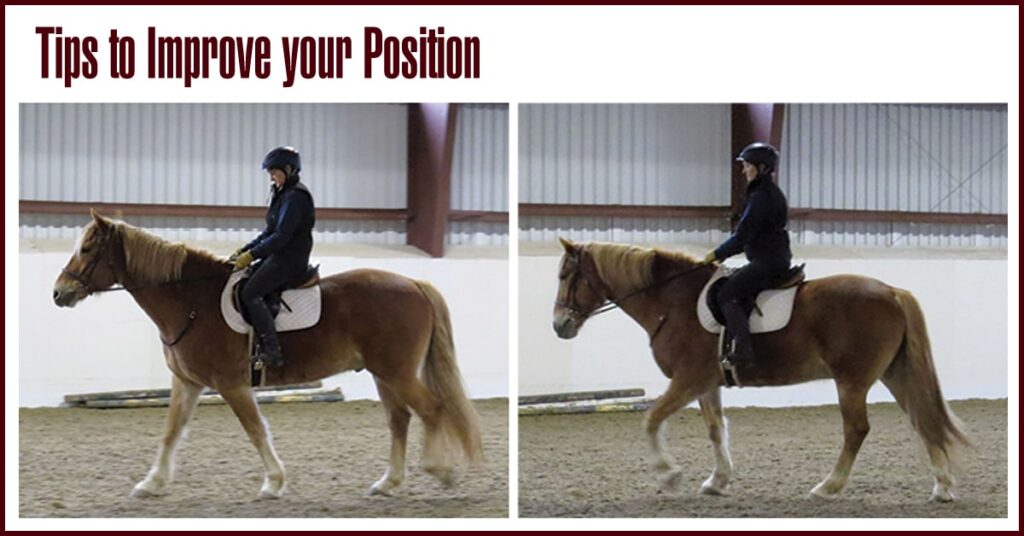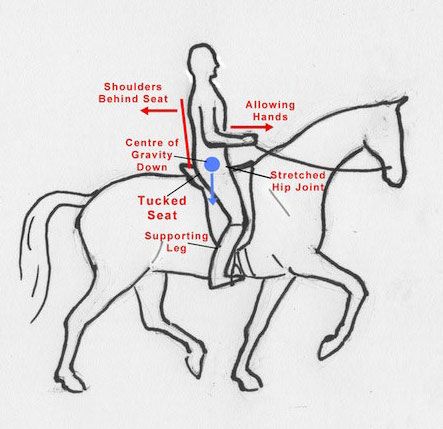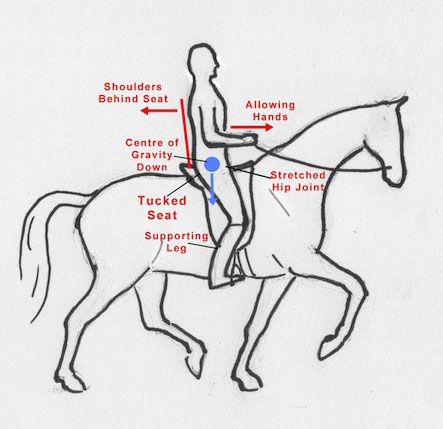Looking to improve your horseback riding skills? Look no further! Our website, “http://horsebackridingdude.com/”, is dedicated to providing comprehensive and engaging content about all things horseback riding. From tips on proper form to the best equipment to use, we cover it all. We’re excited to expand our blog by adding more informative and entertaining posts that will resonate with our audience. So, saddle up and get ready to dive into the world of horseback riding with us!

Proper Horseback Riding Form
Horseback riding is not just about hopping on a horse and taking off into the sunset. It requires proper form and technique to ensure the safety and comfort of both the rider and the horse. Proper form also allows for effective communication between the rider and the horse, enhancing the riding experience. In this article, we will explore the importance of proper form and provide tips and techniques to improve your riding skills.
Importance of Proper Form
Proper horseback riding form is crucial for a variety of reasons. First and foremost, it promotes safety. When you have correct posture and positioning, you are less likely to lose your balance or fall off the horse. This reduces the risk of injuries and accidents while riding.
Additionally, good form allows for effective communication with the horse. Horses respond to subtle cues and signals from the rider, and proper form helps to transmit these signals efficiently. By having a solid foundation in proper riding form, you can develop a stronger connection with your horse and enhance your riding experience.
Finally, proper form improves your overall riding performance. When your body is aligned correctly and your movements are in harmony with the horse, you can achieve better control, balance, and stability. This allows you to perform advanced riding maneuvers with ease and grace.
1. Correct Posture
Maintaining correct posture is essential for proper riding form. Here are some key elements to consider:
1.1 Aligning the Body
Start by aligning your body vertically from your head to your heels. Imagine a straight line running through your ear, shoulder, hip, and heel. This alignment helps distribute your weight evenly and ensures that you stay balanced on the horse.
1.2 Relaxed Upper Body
Keep your upper body relaxed and supple while riding. Avoid stiffness or tension in your shoulders, neck, and back. A relaxed upper body allows you to better absorb the horse’s movement and maintain a stable position.
1.3 Balanced Weight Distribution
Maintain an even distribution of weight in the saddle. Avoid leaning too far forward or backward, as this can throw off your balance and put unnecessary pressure on the horse. Your weight should be evenly distributed between your seat bones and thighs.
2. Correct Leg Position
Proper leg position is essential for maintaining stability and communicating with the horse. Focus on the following aspects:
2.1 Lengthening the Leg
Lengthen your leg down from your hip to your heel. This elongated leg position provides a strong and stable base of support. Avoid gripping with your knees, as this can create tension and hinder communication with the horse.
2.2 Heel Position
Keep your heels down throughout the ride. This helps to maintain a secure and balanced position in the stirrups. Dropping your heels also encourages a correct leg position, with your weight flowing down through your heel and into the stirrup.
2.3 Gripping with the Thigh
Use your thigh muscles to grip the saddle lightly. This grip should be firm enough to maintain your position, but not so tight that it restricts your movement or causes discomfort. The thigh grip helps to stabilize your lower body and aids in communicating with the horse.
3. Proper Hand Position
Having correct hand position is crucial for maintaining control and communicating with the horse through the reins. Consider the following:
3.1 Holding the Reins
Hold the reins with a light and supple grip, allowing for flexibility and sensitivity. Ideally, your hands should be directly in front of you and slightly above the withers of the horse. Avoid pulling back on the reins excessively, as this can create resistance and make it difficult for the horse to respond to your cues.
3.2 Soft Hands
Keep your hands soft and elastic, allowing for a gentle and consistent contact with the horse’s mouth. Avoid stiff or rigid hands, as this can inhibit the horse’s movement and compromise communication. Soft hands allow for better feel and response from the horse.
3.3 Steady Contact
Maintain a steady contact with the horse’s mouth through the reins. This contact should be consistent, yet gentle. Avoid excessive tugging or pulling, as this can confuse or frustrate the horse. A steady contact promotes communication and allows the horse to trust your guidance.
Improving Balance and Stability
Achieving balance and stability in the saddle is essential for becoming a skilled rider. Here are some tips to improve your balance and stability while riding:
4. Core Strength
A strong and engaged core is the foundation of balance and stability. Consider the following:
4.1 Engaging the Core Muscles
Focus on engaging your core muscles while riding. This involves activating the muscles in your abdomen, lower back, and pelvic floor to create a stable and balanced center. A strong core helps you maintain an upright posture and absorb the horse’s movements.
4.2 Exercises to Strengthen the Core
Incorporate exercises that target your core muscles into your regular fitness routine. Pilates, yoga, and exercises such as planks and crunches can all help strengthen your core and improve your riding stability. Additionally, practicing riding without stirrups can also challenge and strengthen your core muscles.
5. Lower Body Stability
Having a stable lower body is essential for maintaining balance and communicating effectively with the horse. Consider the following:
5.1 Strengthening the Lower Body
Work on strengthening your legs, hips, and thighs to improve lower body stability. Exercises such as squats, lunges, and leg presses can help build strength and stability in these areas. Building lower body strength will not only improve your riding form but also reduce the risk of muscle fatigue during long rides.
5.2 Practicing Two-Point Position
The two-point position, also known as the half-seat, is a valuable exercise for improving balance and stability. This position involves slightly rising out of the saddle and maintaining a balanced position with your seat bones just above the saddle. Practice holding this position at various gaits and while navigating obstacles to develop strength and stability in your lower body.
6. Upper Body Control
Having control over your upper body allows for better balance and communication with the horse. Consider the following:
6.1 Developing Upper Body Strength
Incorporate exercises that target your upper body, such as push-ups, tricep dips, and shoulder presses, into your fitness routine. Building upper body strength will not only improve your riding form but also help you maintain control over your reins and communicate effectively with the horse.
6.2 Exercises for Upper Body Control
Practice exercises that challenge your upper body control while riding. Lateral movements, such as leg yields and shoulder-in, require subtle adjustments and coordination of your upper body. Engaging in these exercises will improve your upper body strength and control, allowing for more precise and effective riding.

Aids and Cueing
Aids and cues are the signals we use to communicate with the horse while riding. Understanding and utilizing these aids properly can greatly enhance your riding experience. Consider the following techniques:
7. Using the Seat
Your seat is one of the most important aids in communicating with the horse. Consider the following:
7.1 Sitting Deep in the Saddle
To effectively use your seat, it is essential to sit deep in the saddle. This means connecting with the horse’s movements and following their rhythm. Sitting deep allows you to subtly communicate your intentions to the horse through shifts in your weight and balance.
7.2 Communicating with Weight
Your weight distribution and shifts can convey a variety of cues to the horse. Shifting your weight slightly left or right can indicate the direction you want to turn, while a shift forward or backward can communicate changes in speed or collection. Practice subtle weight shifts to improve your communication with the horse.
8. Leg Aids
Leg aids are used to influence the horse’s movement and direction. Consider the following:
8.1 Using the Leg for Forward Movement
To ask the horse to move forward, apply pressure with both legs squeezing against the horse’s sides. Start with a light pressure and increase if necessary. Releasing the pressure promptly when the horse responds rewards their action.
8.2 Engaging the Leg for Turns and Transitions
To signal turns or transitions, use your leg aids in combination with your seat and other aids. Apply pressure with one leg slightly behind the girth to guide the horse in the desired direction. Experiment with the pressure and timing to achieve clear and effective communication.
9. Rein Aids
Rein aids are used to communicate with the horse through the reins. Consider the following:
9.1 Communicating with the Reins
Your rein aids should be consistent, clear, and gentle. Use your rein aids to provide direction and guidance to the horse. For example, to turn left, gently and evenly pull the left rein toward your body, using your outside rein for support.
9.2 Different Rein Techniques
Different rein techniques, such as direct rein, indirect rein, and neck rein, can be used to communicate different cues to the horse. Learning and practicing these techniques will give you a wider range of options for communicating with your horse and refining your riding skills.
10. Vocal Cueing
Vocal cues can be a valuable addition to your aids and cueing repertoire. Consider the following:
10.1 Using Voice Commands
Training your horse to respond to specific voice commands can enhance your communication with them. Simple commands such as “walk on,” “trot,” “canter,” and “whoa” can help reinforce your other aids and cues. Consistency and clarity are key to effectively using voice commands.
10.2 Establishing Clear Vocal Cues
When using vocal cues, be sure to establish clear and distinct cues for each command. Consistently using the same tone and volume will help your horse understand and respond appropriately. Practice vocal cues during your rides to strengthen the connection between your voice and the horse’s response.

Common Mistakes to Avoid
Even with proper knowledge of form and technique, riders can still fall into common mistakes. These mistakes can hinder communication with the horse and compromise your riding experience. Here are some common mistakes and tips to avoid them:
11. Slouching or Hunching
Slouching or hunching your upper body while riding can negatively impact your balance, communication, and overall riding experience. Consider the following:
11.1 Effects on Balance and Communication
Slouching or hunching disrupts the alignment of your body, making it more difficult to maintain balance and communicate effectively with your horse. It can throw off your weight distribution and hinder the clarity of your aids.
11.2 Correcting the Slouching Position
Consciously focus on sitting tall and maintaining proper alignment throughout your ride. Visualize a string attached to the top of your head, lifting you up and elongating your spine. Strengthening your core muscles and practicing exercises that improve posture, such as yoga or Pilates, can also help correct a slouching position.
12. Gripping with Knees
Using your knees to grip the horse’s sides can be counterproductive and negatively affect your riding form and communication. Consider the following:
12.1 Consequences of Gripping with Knees
Gripping with your knees restricts your lower body movement and interferes with your ability to use your legs and seat aids effectively. It can also cause tension and discomfort in your hips, knees, and lower back.
12.2 Breaking the Habit
Focus on maintaining an elongated leg position with your heels down and engaging your thigh muscles to grip the saddle lightly. Think of wrapping your leg around the horse’s barrel rather than gripping with your knees. Practice exercises that improve leg strength and stability to reinforce this correct leg position.
13. Tensing the Hands
Tensing or gripping the reins too tightly can disrupt the connection and communication between you and your horse. Consider the following:
13.1 Negative Impact on Connection
Tensing your hands restricts the flow of information between your hands and the horse’s mouth. It can cause resistance from the horse and make it difficult for them to understand your cues. It may also lead to discomfort or discomfort for the horse.
13.2 Relaxing and Softening the Hands
Consciously focus on keeping your hands soft, relaxed, and elastic. Maintain a light, consistent contact with the horse’s mouth, allowing for clear communication. Practice exercises and stretches to release tension in your arms, wrists, and hands, such as rolling your wrists or shaking out your hands during breaks.

Tips for Progressing in Form
Improving your riding form is an ongoing process that requires practice and dedication. Here are some tips to help you progress in your form and become a more skilled rider:
14. Regular Practice
Consistency is key when it comes to improving your riding form. Commit to regular riding sessions and exercises that target the specific areas you want to improve. The more you practice, the more natural and automatic correct form will become.
14.1 Importance of Consistency
Set aside dedicated time for riding practice, whether it’s daily, a few times a week, or whatever schedule works best for you. Consistency allows you to reinforce good habits and make progress over time.
14.2 Incorporating Exercises into Routines
In addition to regular riding, incorporate specific exercises and drills into your routines to target different aspects of your riding form. These exercises can be performed both on and off the horse and can focus on areas such as core strength, leg position, and rein control.
15. Seeking Professional Guidance
Working with a knowledgeable instructor or trainer can greatly accelerate your progress in improving your riding form. Consider the following:
15.1 Benefits of Riding Lessons
Taking riding lessons can provide valuable feedback, guidance, and instruction from an experienced professional. They can help identify areas for improvement and provide personalized exercises and techniques to address your specific needs.
15.2 Working with a Trainer
If you’re serious about improving your riding form and skills, consider working with a trainer on a more consistent and long-term basis. Trainers can design tailored training programs to address your goals, providing you with structured guidance and support.
16. Video Analysis
Recording and reviewing your riding sessions through videos can be a valuable tool for self-assessment and improvement. Consider the following:
16.1 Recording and Reviewing Riding Sessions
Use a camera or smartphone to record your rides, focusing on different aspects of your form that you want to improve. Review the videos afterward, paying attention to your posture, leg position, hand position, and overall balance. Take note of areas that need improvement and work on specific exercises to address those areas.
16.2 Identifying Areas for Improvement
Video analysis allows you to see yourself from an outside perspective and identify areas for improvement that may not be immediately noticeable while riding. It can help you develop a better understanding of your riding form and make targeted adjustments.
By focusing on proper form, improving balance and stability, mastering aids and cueing, and avoiding common mistakes, you can enhance your horseback riding experience and become a more skilled and effective rider. Remember, practice and consistency are key to progressing in your form, so keep striving for improvement and enjoy the journey. Happy riding!

